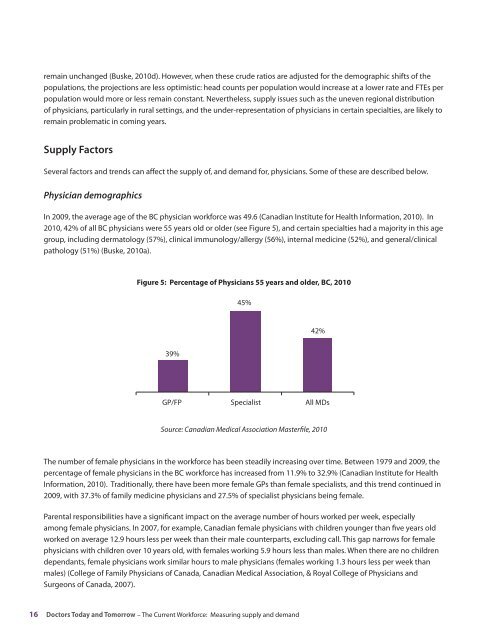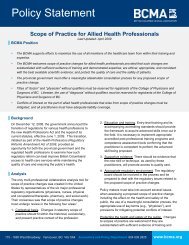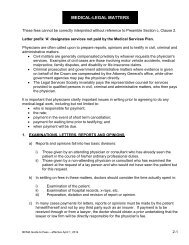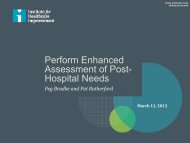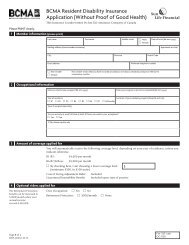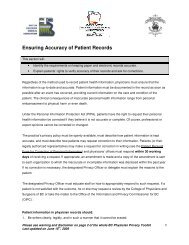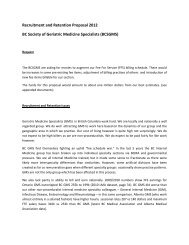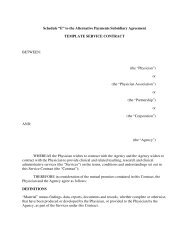Doctors Today and Tomorrow - British Columbia Medical Association
Doctors Today and Tomorrow - British Columbia Medical Association
Doctors Today and Tomorrow - British Columbia Medical Association
Create successful ePaper yourself
Turn your PDF publications into a flip-book with our unique Google optimized e-Paper software.
emain unchanged (Buske, 2010d). However, when these crude ratios are adjusted for the demographic shifts of the<br />
populations, the projections are less optimistic: head counts per population would increase at a lower rate <strong>and</strong> FTEs per<br />
population would more or less remain constant. Nevertheless, supply issues such as the uneven regional distribution<br />
of physicians, particularly in rural settings, <strong>and</strong> the under-representation of physicians in certain specialties, are likely to<br />
remain problematic in coming years.<br />
Supply Factors<br />
Several factors <strong>and</strong> trends can affect the supply of, <strong>and</strong> dem<strong>and</strong> for, physicians. Some of these are described below.<br />
Physician demographics<br />
In 2009, the average age of the BC physician workforce was 49.6 (Canadian Institute for Health Information, 2010). In<br />
2010, 42% of all BC physicians were 55 years old or older (see Figure 5), <strong>and</strong> certain specialties had a majority in this age<br />
group, including dermatology (57%), clinical immunology/allergy (56%), internal medicine (52%), <strong>and</strong> general/clinical<br />
pathology (51%) (Buske, 2010a).<br />
Figure 5: Percentage of Physicians 55 years <strong>and</strong> older, BC, 2010<br />
45%<br />
42%<br />
39%<br />
GP/FP Specialist All MDs<br />
Source: Canadian <strong>Medical</strong> <strong>Association</strong> Masterfile, 2010<br />
The number of female physicians in the workforce has been steadily increasing over time. Between 1979 <strong>and</strong> 2009, the<br />
percentage of female physicians in the BC workforce has increased from 11.9% to 32.9% (Canadian Institute for Health<br />
Information, 2010). Traditionally, there have been more female GPs than female specialists, <strong>and</strong> this trend continued in<br />
2009, with 37.3% of family medicine physicians <strong>and</strong> 27.5% of specialist physicians being female.<br />
Parental responsibilities have a significant impact on the average number of hours worked per week, especially<br />
among female physicians. In 2007, for example, Canadian female physicians with children younger than five years old<br />
worked on average 12.9 hours less per week than their male counterparts, excluding call. This gap narrows for female<br />
physicians with children over 10 years old, with females working 5.9 hours less than males. When there are no children<br />
dependants, female physicians work similar hours to male physicians (females working 1.3 hours less per week than<br />
males) (College of Family Physicians of Canada, Canadian <strong>Medical</strong> <strong>Association</strong>, & Royal College of Physicians <strong>and</strong><br />
Surgeons of Canada, 2007).<br />
16 <strong>Doctors</strong> <strong>Today</strong> <strong>and</strong> <strong>Tomorrow</strong> – The Current Workforce: Measuring supply <strong>and</strong> dem<strong>and</strong>


